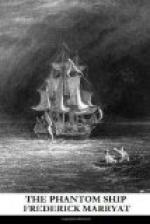To account for the appearance of Father Mathias and the witnesses, it must be observed, that the little boy Pedro had, the day after Amine’s first attempt, forgotten his promise, and narrated to his mother all that had passed. The widow, frightened at what the boy had told her, thought it right to go to Father Mathias, and confide to him what her son had told her, as it was, in her opinion, sorcery. Father Mathias questioned Pedro closely, and, convinced that such was the case, determined to have witnesses to confront Amine. He therefore proposed that the boy should appear to be willing to try again, and had instructed him for the purpose, having previously arranged that they should break in upon Amine, as we have described.
About half-an-hour afterwards, two men dressed in black gowns came into Amine’s room, and requested that she would follow them, or that force would be used. Amine made no resistance; they crossed the square; the gate of a large building was opened; they desired her to walk in, and, in a few seconds, Amine found herself in one of the dungeons of the Inquisition.
Chapter XXXVI
Previous to continuing our narrative, it may be as well to give our readers some little insight into the nature, ceremonies, and regulations of the Inquisition; and in describing that of Goa, we may be said to describe all others, with very trifling, if any, variation.
The Santa Casa, or Inquisition of Goa, is situated on one side of a large square, called the Terra di Sabaio. It is a massive handsome pile of stone buildings, with three doors in the front: the centre one is larger than the two lateral, and it is through the centre door that you go into the Hall of Judgment. The side-doors lead to spacious and handsome apartments for the Inquisitors, and officers attached to the establishment.
Behind these apartments are the cells and dungeons of the Inquisition; they are in two long galleries, with double doors to each, and are about ten feet square. There are about two hundred of them; some are much more comfortable than the others, as light and air are admitted into them: others are wholly dark. In the galleries the keepers watch, and not a word or a sound can proceed from any cell without their being able to overhear it. The treatment of those confined is, as far as respects their food, very good: great care is taken that the nourishment is of that nature that the prisoners may not suffer from the indigestion arising from want of exercise. Surgical attendance is also permitted them; but, unless on very particular occasions, no priests are allowed to enter. Any consolation to be derived from religion, even the office of confessor and extreme unction, in case of dissolution, are denied them. Should they die during their confinement, whether proved guilty or not of the crime of which they are accused, they are buried without any funeral ceremony, and tried afterwards, if then found guilty, their bones are disinterred, and the execution of their sentence is passed upon their remains.




